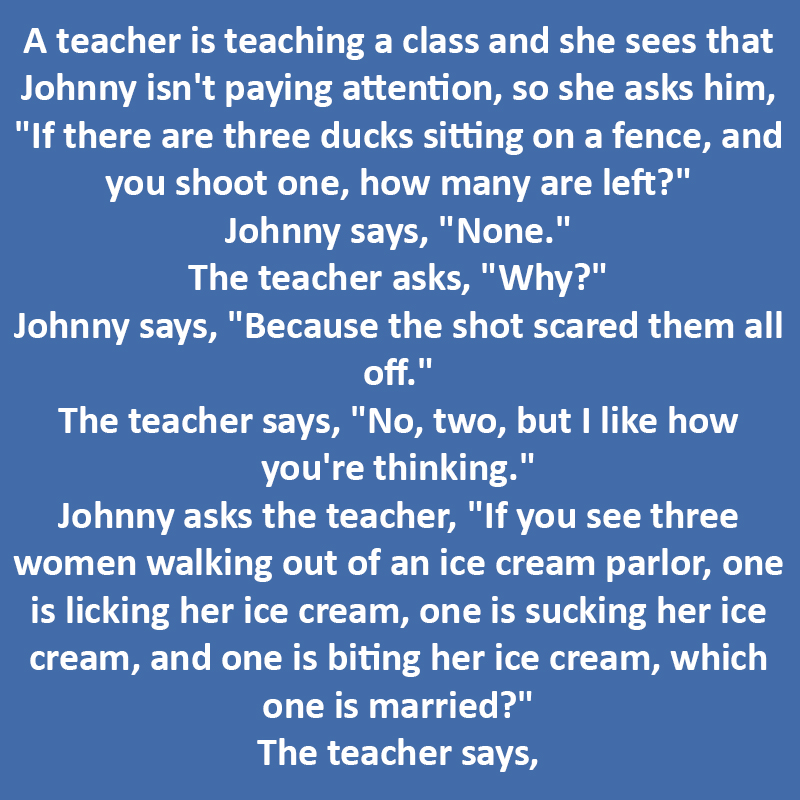A teacher is teaching a class and she sees that Johnny isn’t paying attention, so she asks him,
“If there are three ducks sitting on a fence, and you shoot one, how many are left?”
Johnny says, “None.”
The teacher asks, “Why?”
Johnny says, “Because the shot scared them all off.”
The teacher says, “No, two, but I like how you’re thinking.”
Johnny asks the teacher, “If you see three women walking out of an ice cream parlor, one is licking her ice cream, one is sucking her ice cream, and one is biting her ice cream, which one is married?”
The teacher says, “The one sucking her ice cream.”
Johnny says, “No, the one with the wedding ring, but I like how you’re thinking!”
The joke centers around a humorous interaction between a teacher and her student, Johnny. The setup is a classroom environment where Johnny, a typical mischievous student, isn’t paying attention. The teacher notices this and decides to engage him with a thought-provoking question, aiming to capture his focus. This scenario immediately sets the stage for a playful and slightly intellectual exchange.
The teacher poses a riddle: “If there are three ducks sitting on a fence, and you shoot one, how many are left?” At first glance, the question seems straightforward, with an answer grounded in basic arithmetic. Johnny, however, provides an unexpected response: “None.”
This answer catches the teacher off guard, as it deviates from the logical, numerical answer she was expecting. She asks Johnny to explain his reasoning, to which he responds, “Because the shot scared them all off.” Johnny’s answer showcases a lateral thinking approach, where he considers the broader implications of shooting at the ducks rather than focusing solely on the math.
The teacher acknowledges Johnny’s reasoning but gently corrects him, saying, “No, two, but I like how you’re thinking.” This response highlights her appreciation for his creative thought process, even though it doesn’t align with the textbook answer. This part of the joke establishes the dynamic between the teacher’s structured, logical approach and Johnny’s more imaginative, outside-the-box perspective.
Johnny, emboldened by the teacher’s comment, decides to turn the tables by asking her a question of his own. His riddle is more risqué in nature, reflecting his mischievous personality: “If you see three women walking out of an ice cream parlor, one is licking her ice cream, one is sucking her ice cream, and one is biting her ice cream, which one is married?”
The teacher, likely caught off guard by the suggestive nature of the question, takes a moment to consider her answer. She responds with, “The one sucking her ice cream,” interpreting the question through the lens of implied innuendo. This response reflects the way adults might overanalyze a question based on perceived implications rather than focusing on straightforward observation.
Johnny then delivers the punchline: “No, the one with the wedding ring, but I like how you’re thinking!” This clever reversal mirrors the earlier interaction, where the teacher appreciated Johnny’s creative reasoning. Here, Johnny playfully critiques the teacher’s interpretation, highlighting how her answer was shaped by assumptions rather than the simple, factual observation he was pointing out.
Analyzing the Humor
- Misdirection and Surprise: Both riddles in the joke employ misdirection, leading the listener to anticipate one type of answer before revealing another. In the first scenario, the teacher expects Johnny to approach the problem logically, but he provides a response based on situational context. In the second, the teacher’s assumptions lead her to overthink the question, setting up Johnny’s punchline.
- Role Reversal: The humor is amplified by the reversal of roles. Initially, the teacher holds authority, correcting Johnny’s answer and appreciating his thinking. When Johnny asks his question, he cleverly flips the dynamic, putting the teacher on the spot and delivering a witty critique of her thought process.
- Playful Logic: Both Johnny’s answers demonstrate his ability to think beyond the obvious. His first response shows an understanding of cause and effect (the ducks being scared off by the shot), while his second riddle hinges on straightforward observation (the wedding ring) rather than suggestive implications.
- Cultural Context: The ice cream riddle plays on societal stereotypes and assumptions, making it a bit edgy while remaining humorous. It works because it highlights how people can overinterpret situations based on preconceived notions.
Broader Themes
This joke encapsulates themes of creativity, perception, and the value of thinking differently. Johnny’s character demonstrates the importance of looking beyond surface-level answers, while the teacher’s responses highlight how assumptions can influence reasoning. The exchange is also a lighthearted commentary on the dynamic between authority figures and students, showcasing how cleverness and wit can bridge the gap between them.
In the end, the joke is a classic example of humor that combines wordplay, innuendo, and intellectual mischief. It invites the audience to laugh not only at the punchlines but also at the broader idea of how people interpret questions and situations differently based on their perspectives. This layered humor ensures its enduring appeal, making it a memorable and enjoyable story.


